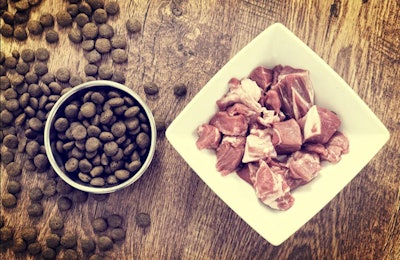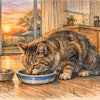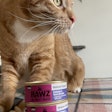
The Association for Pet Obesity Prevention (APOP)’s annual survey revealed that in 2017 pet owners and veterinarians hold different opinions on various dog and cat food trends, such as grain-free, organic and raw pet foods. However, pet owners and vets did agree on some issues. (See infographics below)
Agreements between pet owners and veterinarians
Table scraps and other human foods were one of these areas of agreement between veterinarians and pet owners. In APOP’s survey, “people food” for pets was considered “unhealthy” by 65 percent of pet owners and 67 percent of veterinary professionals agreeing.
Veterinary professionals and pet owners also tended to feed similar styles of pet food to their dogs and cats, although with some variance in dog food. Dry dog food dominated canned or moist with 53 percent of pet owners and 69 percent of veterinary professionals feeding dry kibble to their pets. Canned dog food was preferred by 17 percent of pet owners and 12 percent of veterinary professionals.
Dry versus wet cat diets were more evenly split in the APOP survey. Dry cat food was fed by 49 percent of pet owners and 57 percent of veterinary professionals and canned/moist food by 38 percent of pet owners and 33 percent of veterinary professionals.
Disagreements and areas of confusion among pet owners and veterinarians
Pet owners and veterinarians held somewhat different opinions about organic dog and cat foods, with many pet owners being unsure on the issue. Organic pet food was perceived as “healthier” by 39 percent of pet owners, down from 43 percent in 2016, while 40 percent reported “I don’t know.” Twenty-six percent of veterinary professionals categorized organic pet foods as “healthier,” up from 15 percent in 2016. Seventeen percent of veterinary professionals replied, “I don’t know” when it comes to organic pet foods being “healthier” for pets.
The effect of canned pet food on oral health seemed to cause considerable confusion among both groups. When asked if “feeding a predominantly canned or moist food will damage your pet’s teeth,” 35 percent of petowners and 31 percent of veterinary professionals said “Yes.” Thirty-nine percent of pet owners and 58 percent of veterinary professionals responded “No,” while “I don’t know” earned 26 percent of pet owner responses and 11 percent of veterinary professionals.
Raw diets continue to divide these two groups, although support of raw diets among pet owners appears to be diminishing and confusion increasing.
Do you think raw diets are healthier for dogs and cats?
- “Yes” – 28 percent of pet owners (35 percent in 2016) and 13 percent of veterinary professionals (15 percent
- in 2016)
- “No” – 28 percent of pet owners (30 percent in 2016) and 72 percent of veterinary professionals (71 percent
- in 2016)
- “I don’t know” – 45 percent of pet owners (35 percent in 2016) and 15 percent of veterinary
- professionals (14 percent in 2016)
Pet owners also reported confusion and disagreed with veterinary professionals about low- and no-grain diets and corn.
Are low- or no-grain diets healthier for dogs?
- “Yes” – 46 percent of pet owners and 21 percent of veterinary professionals
- “No” – 12 percent of pet owners and 63 percent of veterinary professionals
- “I don’t know” – 43 percent of pet owners and 16 percent of veterinary professionals
Do you think corn is healthy for dogs?
- “Yes” – 5 percent of pet owners and 50 percent of veterinary professionals
- “No” – 63 percent of pet owners and 30 percent of veterinary professionals
- “I don’t know” – 31 percent of pet owners and 20 percent of veterinary professionals
Do you think corn is healthy for cats?
- “Yes” – 3 percent of pet owners and 34 percent of veterinary professionals
- “No” – 63 percent of pet owners and 46 percent of veterinary professionals
- “I don’t know” – 34 percent of pet owners and 20 percent of veterinary professionals
Regardless of pet owners and veterinarians opinions on dogs and cat food varieties, one issue related to pet food continued to show an increasing trend: pet obesity.
US dog, cat obesity rose in 2017
APOP’s survey provided evidence that pet obesity in the US increased in 2017, affecting 60 percent of cats and 56 percent of dogs.
“The number of pets with clinical obesity continues to increase,” said APOP founder Ernie Ward, DVM, in a press release. “We’re continuing to see more pets diagnosed with obesity rather than overweight. Clinical obesity results in more secondary conditions such as arthritis, high blood pressure, kidney disease, and certain forms of cancer. Pets with obesity also have reduced quality of life and shorter life expectancy.”
In the October 2017 clinical survey, 56 percent of dogs and 60 percent of cats were classified as overweight (body condition score (BCS) 6-7) or obese (BCS 8-9) by their veterinary healthcare professional. These results indicate an estimated 50.2 million dogs and 56.5 million cats are above healthy weight, based on 2017 pet population projections provided by the American Pet Products Association (APPA). In 2016, APOP found 54 percent of dogs and 59 percent of cats were overweight or obese in the U.S.
Pet owners’ and veterinarians’ views on pet obesity
Pet owners and veterinary professionals were questioned about pet obesity, diet and nutrition, and sources of pet food advice. Fifty-eight percent of pet owners and 54 percent of veterinary professionals reported they had tried to help their own pet lose weight. Low-calorie and weight loss diets combined with increased exercise were the most cited weight loss strategies.
However, forty-eight percent of pet owners stated that their veterinarian failed to recommend a maintenance or routine diet for their pet and 15 percent commented that they “had to ask” to receive a pet food recommendation. Fifty percent of surveyed veterinary professionals replied they offered maintenance pet food recommendations.
Pet obesity survey methodology
The 2017 survey included the assessment of 1,610 dogs and 714 cats by 178 veterinary practives. The online questionnaire was completed by 1,215 pet owners and 544 veterinary professionals from October 11 to December 31, 2017.
Veterinary practices assessed the body condition scores of every dog and cat patient they saw for a regular wellness exam on a given day during the study period. Body condition scores based on a whole-integer, nine-point scale and actual weight were used in classifying pets as either underweight, thin, ideal, overweight or obese.















